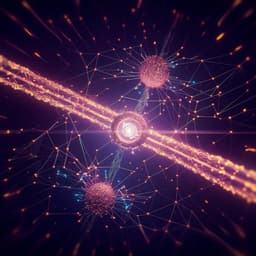
Physics
Quantum Algorithmic Measurement
D. Aharonov, J. Cotler, et al.
Explore the groundbreaking research by Dorit Aharonov, Jordan Cotler, and Xiao-Liang Qi that introduces a fascinating framework for quantum experiments called Quantum Algorithmic Measurements (QUALMs). This work reveals a significant exponential speedup in distinguishing Hamiltonians, paving the way for advances in quantum many-body physics.
Playback language: English
Introduction
The integration of quantum computing principles into experimental physics has shown promise in improving precision and efficiency. However, a systematic theoretical framework for analyzing these hybrid quantum experiments was lacking. This research addresses this gap by proposing the QUALM framework, which treats experiments as computations where the input is a physical system, not a classical description. This framework views experiments as functions mapping input physical systems to classical outcomes. Unlike standard algorithms, the input isn't fully classically described; the experimentalist interacts with the system via quantum operations and measurements. The authors posit that any quantum experiment can be efficiently simulated by a QUALM, extending the quantum Church-Turing thesis to the experimental realm. This is a significant departure from traditional approaches where experiments are seen as merely measurement procedures. The paper focuses on the computational complexity of performing experiments to extract specific information about the physical system. This allows for the quantification and comparison of different experimental techniques' efficiency based on computational resources needed.
Literature Review
The paper acknowledges a growing body of work using quantum computing elements in experiments, hinting at the potential for dramatic enhancements in experimental capabilities. However, it points out the absence of a comprehensive theoretical framework to analyze the resource requirements and limitations of these more general quantum experiments. The authors reference the quantum Church-Turing thesis, stating that any physical process can be efficiently simulated by a quantum algorithm. They mention that previous work has laid some groundwork for their approach, and they cite several papers suggesting that quantum tools might provide improvements to experimental capabilities. The paper also mentions related work on quantum strategies, quantum combs, and quantum interactive protocols, which inform their definition of QUALMs. However, they argue that previous work is insufficient to provide a universal framework for characterizing the efficiency of experimental procedures. The focus of previous efforts on query complexity is highlighted as insufficient, because the total computational cost of the proposed coherent protocol was not known to be efficient.
Methodology
The core of the methodology is the development of the QUALM framework. A QUALM is modeled using three registers: 'Nature' (N), representing the inaccessible parts of the physical system under study; 'Lab' (L), representing the accessible degrees of freedom that interact with N; and 'Workspace' (W), representing the experimentalist's controlled degrees of freedom used for computation and measurement. An experimental task is defined as a function from lab protocols (quantum circuits) to classical outputs. A QUALM is a specific experimental protocol (a sequence of operations on L and W, interspersed with applications of a black box operator acting on N and L) designed to accomplish a given task. The paper introduces the concepts of coherent and incoherent QUALMs. Coherent QUALMs allow for general unitary operations on the lab and workspace, while incoherent QUALMs only allow classical communication between these registers. The computational complexity of a QUALM is measured by the number of gates and lab oracle applications. The paper then focuses on two example tasks: (1) distinguishing a time-independent Hamiltonian from a time-dependent one, modeled by the 'fixed unitary problem'; and (2) determining the symmetry class of a system's dynamics, modeled by the 'Symmetry Distinction Problem'. For both tasks, the authors prove that coherent QUALMs offer an exponential speedup over incoherent QUALMs. The proof for the fixed unitary problem involves reducing incoherent QUALMs to simpler 'simple measurement QUALMs' and then showing that these require an exponential number of measurements to distinguish the two cases. This involves leveraging the Wangartin decomposition and using insights from group theory. The rigorous mathematical derivations are detailed in the Methods section and Supplementary Information.
Key Findings
The central finding is the demonstration of an exponential advantage of coherent QUALMs over incoherent QUALMs for two physically motivated problems. This means that leveraging the quantum coherence between different experimental steps can lead to exponentially fewer resources (gates and measurements) being required to perform certain types of experiments. For the 'fixed unitary problem', which involves distinguishing between a system with a constant Hamiltonian and a time-dependent one, the authors prove a lower bound of Ω(2^n) on the complexity of any incoherent QUALM for an n-qubit system. They show that a simple coherent QUALM using the SWAP test can solve this problem efficiently. Similarly, for the 'Symmetry Distinction Problem,' which involves identifying the symmetry of a many-body system's dynamics, the authors argue that a coherent QUALM can achieve a significant exponential advantage. The proofs rely on reducing incoherent QUALMs to simpler models (simple measurement QUALMs) and then applying techniques from quantum information theory and group theory to establish the exponential lower bounds. The authors rigorously define their framework and provide formal definitions and theorems to support their claims. The results are further strengthened by showing that even adaptive incoherent QUALMs do not overcome the exponential barrier.
Discussion
The results demonstrate that the ability to use quantum coherence between different stages of an experiment leads to a dramatic reduction in the required experimental resources, indicating a new type of quantum advantage. This contrasts with the commonly studied quantum algorithm advantage where the input is already a classical description of the problem. This has significant implications for experimental quantum physics, suggesting that future experiments should aim to exploit quantum coherence to achieve significant improvements in efficiency and precision. The authors discuss the implications of their findings in relation to existing quantum algorithms such as Simon's algorithm, arguing that their framework offers a more general and physically relevant approach to analyzing the complexity of quantum experiments. The proposed QUALM framework provides a new tool for designing and analyzing quantum experiments, potentially leading to innovative experimental protocols that are both more efficient and more accurate. The authors also propose their QUALM framework as a generalization of existing protocols and suggest its applicability for characterizing other experimental tasks.
Conclusion
This paper introduces the QUALM framework, providing a novel theoretical foundation for analyzing the computational complexity of quantum experiments. The authors demonstrate an exponential advantage of coherent QUALMs over incoherent ones for specific tasks, highlighting the importance of exploiting quantum coherence in experimental design. This work opens new avenues for research in designing more efficient and powerful quantum experiments and for further exploring the boundaries of quantum computation in the context of physics experiments. Future work could extend this framework to other experimental tasks and explore the practical implications of the findings for designing real-world quantum experiments.
Limitations
The study focuses on specific toy models (fixed unitary problem and symmetry distinction problem) to demonstrate the exponential advantage of coherent QUALMs. While these models capture important aspects of realistic experimental scenarios, they might not fully encompass the complexity of all quantum experiments. Further research is needed to explore the applicability of the QUALM framework to a broader range of experimental problems. The assumptions underlying the models (e.g., access to ideal quantum gates and perfect measurements) might not hold in real-world implementations, potentially impacting the observed speedups. The practical implementation of the proposed coherent QUALMs might also face challenges due to experimental limitations in manipulating and controlling quantum systems.
Related Publications
Explore these studies to deepen your understanding of the subject.







